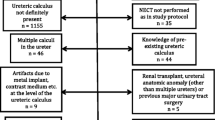Abstract
Purpose
To evaluate the ability of a semi-automated radiomic analysis software in predicting the likelihood of spontaneous passage of urinary stones compared with manual measurements.
Methods
Symptomatic patients visiting the emergency department with suspected stones in either kidney or ureters who underwent a CT scan were included. Patients were followed for up to 6 months for the outcome of a trial of passage. Maximum stone diameters in axial and coronal images were measured manually. Stone length, width, height, max diameter, volume, the mean and standard deviation of the Hounsfield units, and morphologic features were also measured using automated radiomic analysis software. Multivariate models were developed using these data to predict subsequent spontaneous stone passage, with results expressed as the area under a receiver operating curve (AUC).
Results
One hundred eighty-four patients (69 females) with a median age of 56 years were included. Spontaneous stone passage occurred in 114 patients (62%). Univariate analysis demonstrated an AUC of 0.83 and 0.82 for the maximum stone diameter determined manually in the axial and coronal planes, respectively. Multivariate models demonstrated an AUC of 0.82 for a model including manual measurement of maximum stone diameter in axial and coronal planes. The same AUC was found for a model including automatic measurement of maximum height and diameter of the stone. Further addition of morphological parameters measured automatically did not increase AUC beyond 0.83.
Conclusion
The semi-automated radiomic analysis of urinary stones shows similar accuracy compared with manual measurements for predicting urinary stone passage. Further studies are needed to predict clinical impacts of reporting the likelihood of urinary stone passage and improving inter-observer variation using automatic radiomic analysis software.



Similar content being viewed by others
Data Availability
Available upon request from the corresponding author.
References
Bultitude M, Rees J (2012) Management of renal colic. BMJ 345:e5499
Smith RC, Verga M, McCarthy S, Rosenfield AT (1996) Diagnosis of acute flank pain: value of unenhanced helical CT. AJR Am J Roentgenol 166(1):97–101
Turk C, Petrik A, Sarica K, Seitz C, Skolarikos A, Straub M, Knoll T (2016) EAU guidelines on diagnosis and conservative management of urolithiasis. Eur Urol 69(3):468–474
Niemann T, Kollmann T, Bongartz G (2008) Diagnostic performance of low-dose CT for the detection of urolithiasis: a meta-analysis. AJR Am J Roentgenol 191(2):396–401
Tamm EP, Silverman PM, Shuman WP (2003) Evaluation of the patient with flank pain and possible ureteral calculus. Radiology 228(2):319–329
Ray AA, Ghiculete D, Pace KT, Honey RJ (2010) Limitations to ultrasound in the detection and measurement of urinary tract calculi. Urology 76(2):295–300
Ganesan V, De S, Greene D, Torricelli FC, Monga M (2017) Accuracy of ultrasonography for renal stone detection and size determination: is it good enough for management decisions? BJU Int 119(3):464–469
Coll DM, Varanelli MJ, Smith RC (2002) Relationship of spontaneous passage of ureteral calculi to stone size and location as revealed by unenhanced helical CT. AJR Am J Roentgenol 178(1):101–103
Association AU Kidney Stones https://www.auanet.org/education/kidney-stones.cfm. Accessed 02/23/2016
Kampa RJ, Ghani KR, Wahed S, Patel U, Anson KM (2005) Size matters: a survey of how urinary-tract stones are measured in the UK. J Endourol 19(7):856–860
Nazim SM, Ather MH, Khan N (2014) Measurement of ureteric stone diameter in different planes on multidetector computed tomography--impact on the clinical decision making. Urology 83(2):288–292
Demehri S, Steigner ML, Sodickson AD, Houseman EA, Rybicki FJ, Silverman SG (2012) CT-based determination of maximum ureteral stone area: a predictor of spontaneous passage. AJR Am J Roentgenol 198(3):603–608
Duan X, Wang J, Qu M, Leng S, Liu Y, Krambeck A, McCollough C (2012) Kidney stone volume estimation from computerized tomography images using a model based method of correcting for the point spread function. J Urol 188(3):989–995
Manzoor MAP, Agrawal AK, Singh B, Mujeeburahiman M, Rekha PD (2019) Morphological characteristics and microstructure of kidney stones using synchrotron radiation muCT reveal the mechanism of crystal growth and aggregation in mixed stones. PLoS One 14(3):e0214003
Gucuk A, Uyeturk U (2014) Usefulness of hounsfield unit and density in the assessment and treatment of urinary stones. World J Nephrol 3(4):282–286
Jendeberg J, Geijer H, Alshamari M, Cierzniak B, Liden M (2017) Size matters: the width and location of a ureteral stone accurately predict the chance of spontaneous passage. Eur Radiol 27(11):4775–4785
Sfoungaristos S, Kavouras A, Perimenis P (2012) Predictors for spontaneous stone passage in patients with renal colic secondary to ureteral calculi. Int Urol Nephrol 44(1):71–79
Choi T, Yoo KH, Choi SK, Kim DS, Lee DG, Min GE, Jeon SH, Lee HL, Jeong IK (2015) Analysis of factors affecting spontaneous expulsion of ureteral stones that may predict unfavorable outcomes during watchful waiting periods: what is the influence of diabetes mellitus on the ureter? Korean J Urol 56(6):455–460
Jendeberg J, Geijer H, Alshamari M, Liden M (2018) Prediction of spontaneous ureteral stone passage: automated 3D-measurements perform equal to radiologists, and linear measurements equal to volumetric. Eur Radiol 28(6):2474–2483
Patel SR, Wells S, Ruma J, King S, Lubner MG, Nakada SY, Pickhardt PJ (2012) Automated volumetric assessment by noncontrast computed tomography in the surveillance of nephrolithiasis. Urology 80(1):27–31
Code availability
Not available.
Funding
Research reported in this work was supported by the National Institutes of Health under award number U54 DK100227 and R01 EB028591. The content is solely the responsibility of the authors and does not necessarily represent the official views of the National Institute of Health.
Author information
Authors and Affiliations
Corresponding author
Ethics declarations
Conflict of interest
JF and CM receive research funding from Siemens Healthcare GmbH. The other authors declare that they have no conflict of interest.
Additional information
Publisher’s note
Springer Nature remains neutral with regard to jurisdictional claims in published maps and institutional affiliations.
Rights and permissions
About this article
Cite this article
Mohammadinejad, P., Ferrero, A., Bartlett, D.J. et al. Automated radiomic analysis of CT images to predict likelihood of spontaneous passage of symptomatic renal stones. Emerg Radiol 28, 781–788 (2021). https://doi.org/10.1007/s10140-021-01915-4
Received:
Accepted:
Published:
Issue Date:
DOI: https://doi.org/10.1007/s10140-021-01915-4




